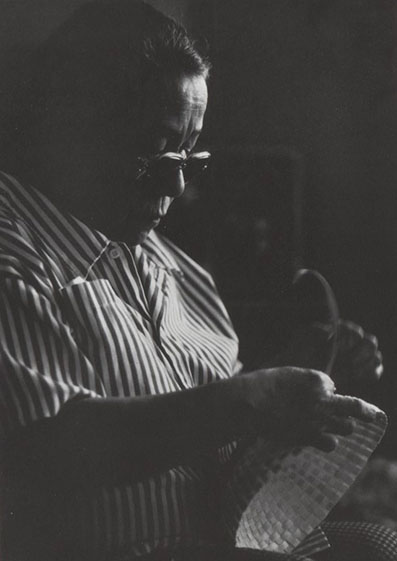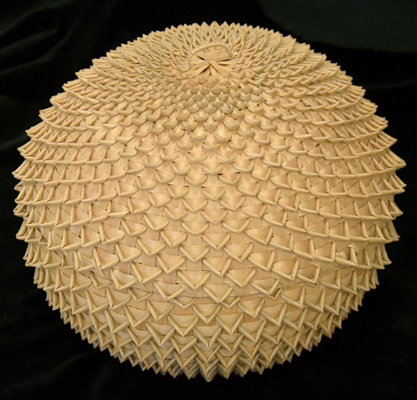Art Form: Anishinaabe black ash basket making
Location(s): Hubbard Lake (Alcona County)
Edith Bondie

Portrait of Edith Bondie

Edith Bondie carving splints in her home

Edith Bondie making her signature basket form; photo by Al Kamuda

Edith Bondie weaving a basket

"Porkypine Basket," Edith Bondie, c. 1988-1992. Collection of the MSU Museum, donated by Chester Sernak in memory of his late wife Bonnie J. Miljour
Born in Mikado, the Ojibwa community located in a rural area near Oscoda, Edith Bondie's (1918-2005) life was always been closely connected to the woods. Her father drove logs down the AuSable River, and her mother was a lumberjack cook who often worked out of a shanty kitchen on a river raft. Edith was raised in Mikado where she learned traditional black ash splint basketmaking techniques from her parents and others. "My mom made baskets and she'd throw us kids the scraps. We'd pick them up and play with them and started making baskets on our own. And I've been making them all my life." (1)
For many years Edith and her husband, Ward, worked together on baskets. Ward felled the right black ash trees on their property best suited for baskets, and the two of them took turns pounding the logs and separating the splints. Edith's baskets are known for their thin, smooth, and narrow splints. Aside from the time it takes to gather and prepare the materials, Edith said it took her "up to six weeks, working eight to ten hours a day, to finish one basket." (2)
Although she was adept at making many kinds of utility and decorative baskets, Edith is best known for one basket. She called it a "porcupine basket" or a "blowfish basket." As she described it, "You know that ocean fish that blows itself up a lot--the blow fish? It looks like a big balloon with lots of needles all over it. Well, that's what the baskets are supposed to look like." (3) These basket feature curled and twisted splints creating pin cushion-type texture that mimics the fish she described.
Edith's work has been featured in many exhibits, including at the Jesse Besser Museum, MSU Museum, and, in 1979, as part of the exhibit titled "Craft Multiples" at the Smithsonian Institution's Renwick Gallery. Edith very generously shared her skills with many others and was a featured teacher and demonstrator at county fairs, 4-H clubs, Jesse Besser Museum, and MSU Museum.
(1) Bondie, Edith. Cited in Alan R. Kamuda, Hands Across Michigan: Tradition Bearers. Detroit, Michigan: Detroit Free Press. 1993:48.
(2) Bondie, Edith. Cited in Alan R. Kamuda, Hands Across Michigan: Tradition Bearers. Detroit, Michigan: Detroit Free Press. 1993:48.
(3) Bondie, Edith. Cited in Alan R. Kamuda, Hands Across Michigan: Tradition Bearers. Detroit, Michigan: Detroit Free Press. 1993:48.





